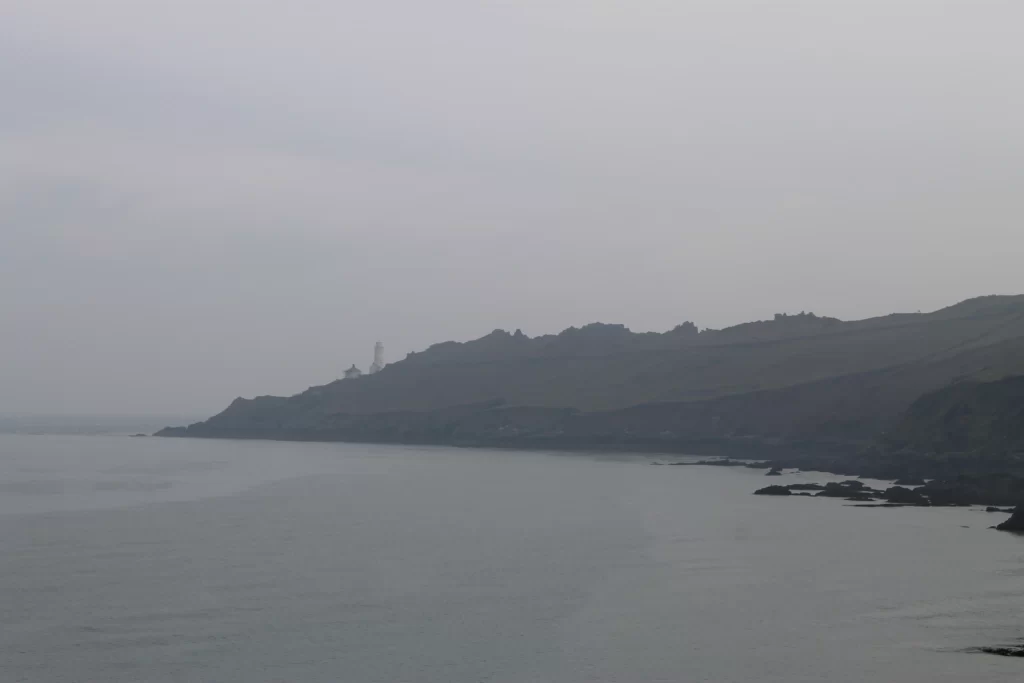This is the first blog post in our abandoned places of the United Kingdom series. We had planned to go to Tyneham, a village in Dorset that has a population of 0 due to being in the centre of a Ministry of Defence firing range. Unfortunately, the trip didn’t go to plan, but more on that later!
The Early Bird Catches the Worm – Or Not
We had met and discussed this trip in advance of our departure due to needing to ensure we were visiting Tyneham at a time that the army weren’t using it. Their website lists days when Tyneham is closed and we were confident given the information on the site that the village would be open. The aim was to start early, drive the three-hour trip in the morning and then spend the day in Tyneham, exploring, taking pictures and finding out about the history of the place.
That meant, as the designated driver, I would have to be up at 6am, get showered, get to Blair’s for 7am and then onwards to Izzy for a 7:30am pick up. Frequently being the person that struggles with early morning starts of the three of us, my trip mates didn’t seem to have much faith that I would stick to the schedule. At 7:10am I was outside Blair’s house, still waiting as he finished off his shave.
I had arrived on time and this preparedness had evidently caught him off guard. I made up six minutes in the charge from Basildon to Chelmsford and by the time I had picked up Izzy we were only four minutes behind schedule. Fortunately, Izzy was ready and waiting and before long we were on our way for an adventure we thought would begin and end in Tyneham.
The Drive to Tyneham
Fog had fallen heavily the night before and even at daybreak it had not dissipated. Visibility in the early morning light was relatively poor and for the first hour or so I was making use of the fog lights on my Mercedes Benz C250 (one of which is not currently working!). That didn’t deter me from keeping up a consistent speed and within that foggy hour we had cleared the M25 stretch of our journey and were bombing down the M3 towards Bournemouth. I had looked the day previous on my phone for Tyneham and noticed it was pretty much within a stone’s throw of Bournemouth.
Soon, the sunshine cleared the last of the fog and the day brightened up quickly. The forecast had said it would be hotter than Barcelona in the UK for our travel day and I was looking forward to a sun-soaked day of adventuring.
Tyneham itself, is a little off of the beaten track. Normally I use my car’s voice control to tell the SATNAV where to take me (in the rare event I use SATNAV) and it will find the intended target and then calculate the route. This didn’t happen when searching for Tyneham, meaning that the developers hadn’t programmed it into the database. Reassuring, considering the point of our trip was to explore an abandoned place and one that is not on a computer is likely not to be well known or travelled to.
Both my travelling companions had started the day a little less fresh than I, both were subdued, leaving me to talk excitedly about the things we might find in Tyneham. My deduction was that Blair was still half asleep, and Izzy is not much of a talker at the best of times (she is quite the daydreamer), let alone in a car and being woken at the break of dawn. Once we had opened the roof and windows and the cool spring breeze was funnelled in, they perked up a bit.
It took the warm wind to liven Blair up, and soon he was engaging me with excited conversation as well as putting his hands out of the roof (because he said he hadn’t got a sunroof) like a child.
Tyneham – A Disappointing Start
We reached Tyneham in good time and with a half hour pitstop to grab a McDonald’s breakfast the overall journey was just under 4 hours. Putting us at our destination just before midday. Despite it not being keyed into our onboard SATNAV we found Tyneham with relative ease, it was signposted clearly as we drew nearer. Another thing I spotted from the winding road was a large stately home tucked away in a copse behind a lot of woodland. I made a note of it as a point of interest to revisit it on our return journey and get a closer look.
The track to Tyneham narrowed to a road that just about allowed two vehicles to pass side by side, we climbed up into the rolling hills and were greeted by an unwelcome sight near the summit. The range flags were hoisted, meaning that there were military exercises being conducted in the area. We got to a gate that would ordinarily be the entrance to the abandoned village where we were greeted by a woman who informed us that the Territorial Army had booked the area at the last minute and hadn’t had time to update the website.
MOD if you’re reading this, it would be a courtesy if the site is updated regularly to ensure visitors to the area don’t spend money on fuel and waste time travelling!
This left us in a predicament, we had driven a fairly long way and had nothing to see or do. Rules can be broken on occasion but the thought of having live munitions whizzing past as we tried to take photos wasn’t appealing and common sense prevailed. Tyneham would have to wait until another day.
The Eerie Stately Home
We drove on from the gate and stopped further up the hill where we convened to decide what to do (and both me and Blair were busting to go to toilet). The landscape around us was nice but I wouldn’t go so far as to call it pretty, instead it was what you might imagine rural Britain to look like, steep hills and valleys and lots of cows and sheep. There are certainly some jaw dropping landscapes in the United Kingdom, but they will wait until future blogposts.
We had planned our entire abandoned places UK blog series in advance, our meeting at the top of the hill was a brief one as a result. We resolved to venture on and further down the coast to a village in Devon called Hallsands. Originally intended to be part two of our series it found itself thrust to pole position. One thing was certain, we weren’t going anywhere until I had satisfied my curiosity and had a closer look at that house.
It turned out that the house at the foot of the hills is actually Creech Grange.
Creech Grange
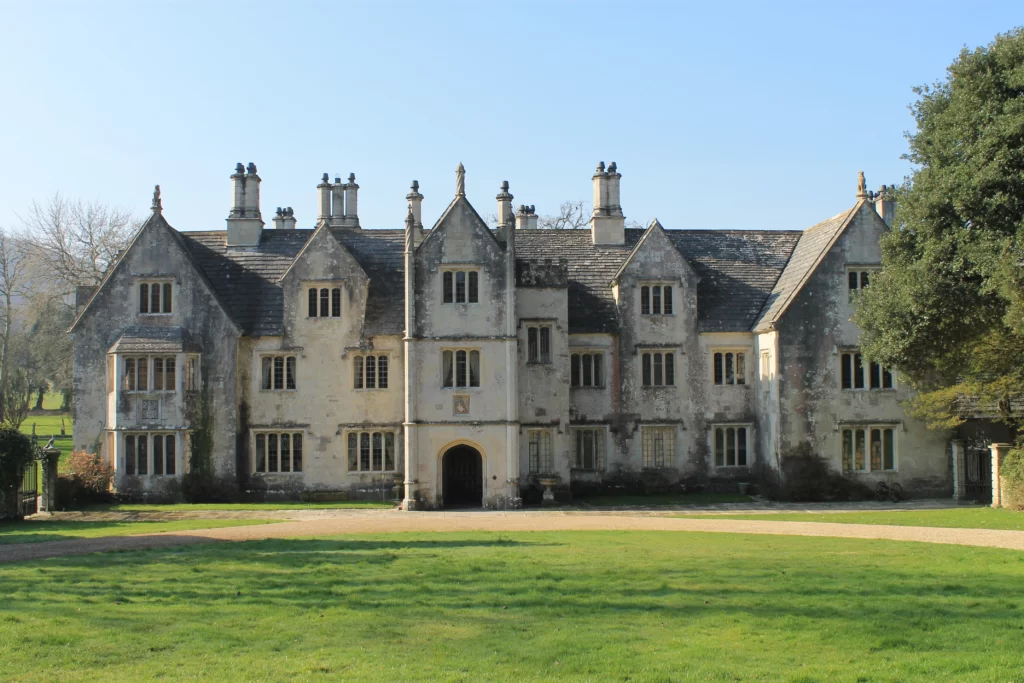

We drove up a long and sweeping drive until we reached an open area at what is presumably the front of the property. We stopped briefly to grab some photos before departing, being conscious that the place looked inhabited and it was quite possible that we had driven up to someone’s house. In fact, after later reading (when we had returned home from our escapade) it turns out this house is indeed inhabited and is open to the public for a small fee.
There was no indication at the time of this and we were fairly certain we had driven onto someone’s private property (which technically we had) so a brief stop was all we afforded ourselves before driving on. Before I continue the story though, as with any adventure there are always little highlights and details that will take you off of the main narrative. Creech Grange is one of those and I will give you a bit more insight into it before we continue.
Creech Grange is a stately home that is categorised as a grade I listed building with its accompanying gardens being grade II listed. The grade I listing means that it is preserved in its entirety as you see it without possibility of alteration. It dates back to the Tudor times and was originally built after Henry VIII had his infamous break with the Catholic church and in doing so abolished monasteries and prevented the church from owning land.
Sir Oliver Lawrence bought the land from Bindon Abbey which is near a small town called Wool and set about building a large home for himself and his family. Much of the original building no longer exists with some of it being damaged by fire during the English Civil War and the façade being completely renovated in 1846 to keep the manor in line with local tradition, which incidentally was Tudor styled.
The house was sold in 1691 to Nathaniel Bond who was prominent in stature because he was the fourth son of a leading politician at the time. It has since remained in the Bond family, being passed down from generation to generation and remains in the family’s estate to this day. Like with many stately homes and families that own them, Creech Grange appears grandiose, but upon closer inspection it could do with work to maintain it.
A problem with such houses is that although the estate is very wealthy (after all, the property is probably worth at least £10 million), they are costly to maintain and this can mean a family that inherits such a property might not be particularly affluent because the wealth is tied up in the property and not available at the bank. This is why many stately homes are open to the public in order to generate revenue for upkeep whilst the property itself is still a home.
There are a few interesting quick facts about Creech Grange and then we will move on with our adventure!
- The original owner Sir Oliver Lawrence was an ancestor to George Washington who founded the United States of America.
- Creech Grange itself has indications of this with stars and stripes being part of the house’s coat of arms and on other furnishings. These pre-dated Washington and it is likely he carried these symbols from his family tree over to the US.
- The estate (a portion of the land) is also listed as a “Site of Special Scientific Interest” due to it being an important roosting area for Greater Horseshoe Bats.
- Despite its rather gothic/Tudoresque frontage, the remainder of the house is more formally styled and bears hallmarks of Georgian architecture. From the side you could easily mistake it for a different house altogether.
Onwards to Hallsands
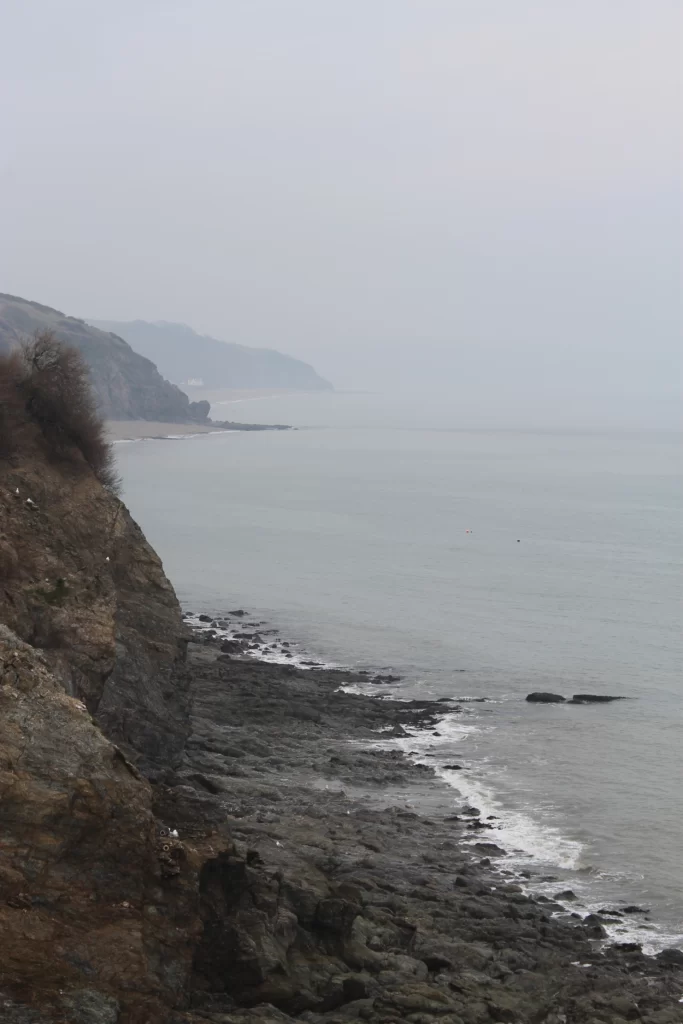

Driving from Creech Grange we made our way onto the A-roads that join Dorset and Devon before making it onto the M5 motorway past Exeter and beyond towards Torquay. Hallsands was on our list of abandoned places but unlike Tyneham (which we had planned for), we hadn’t read up in advance about Hallsands and we’re going in blind without knowing what to expect.
Our trepidation was made worse as we ventured on and the M5 became a dual carriageway, which in turn became an ordinary road. If the road network had remained at the ordinary road stage, our trip to Hallsands would likely have been uneventful. It didn’t.
Soon the roads we were being directed onto (my SATNAV recognised Hallsands) were becoming increasingly rural. By rural, I mean they were the worst roads I have driven on, littered with potholes and sharp turns with just room for one vehicle. Adding to the discomfort of driving down them were the sharp and sweeping inclines. In other words, some of the hills were so steep that you had to pick up speed to reach a blind summit that you had no idea if another oncoming vehicle was doing the other side.
This resulted in a grand total of three almost collisions that were thankfully avoided due to sharp reflexes, good brakes and evasive driving. At one point both myself and an oncoming Landrover were aiming ourselves at opposite sides of the very tight road to limit the impact. Thankfully, the brakes did their job and the crash was avoided. Cheerily he raised his hand in a thankful gesture, smiled and drove on after I had backtracked to let him through.
At the moment we had nearly collided, Blair had let out the most unusual noise, resembling what I imagine a moose sounds like. This casual friendly wave did nothing to settle the shaken mood of my passengers, Blair being white as a sheet and I suspect his boxers were as brown as the tan leather seats (though he vehemently denied this). Driving on, I wondered what kind of insurance premiums the residents pay with such occurrences being typical enough to smile and then go about your day.
We arrived at Hallsands in one piece, my eyes still wet from laughing so much about the noise Blair had made. Parking in a small carpark there was a box saying a kind donation of £2 would be appreciated. None of us had any cash on us, meaning that we would be the “unkind” visitor that doesn’t contribute.
It is quite difficult to navigate to Hallsands, even though it is clearly marked on the map and there are signposts, it is disorientating trying to get there (especially as it was our first and likely only time) and the steep verges at the side of the road make it impossible to get your bearing.
Hallsands – A Village Lost to the Sea
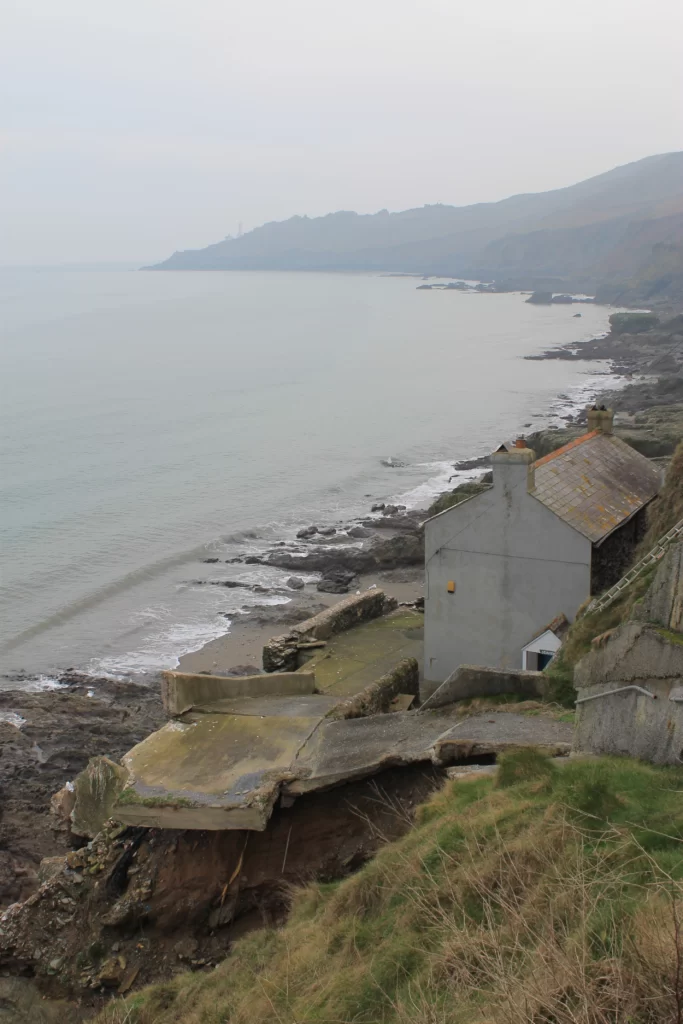

We meandered down a steep hill towards the coastline where Hallsands is (was), past a relatively new apartment complex that forms the modern Hallsands populace. Reaching the coastal path, we see a sharp cliff drop where the sea has eroded the coastline drastically over the last hundred years. To the right is a viewing platform and further right is what remains of Hallsands.
If you’re planning a trip to Hallsands be prepared that there is no access to the ruined village, it is securely gated off and even if you were brave enough to jump the gate there is no way of getting across the cliff face safely to reach the village. Even the concrete walkway that was built more recently has collapsed as the cliff subsided underneath it.
There is a thirty foot drop now in its place. Below the sea was crashing in, even on a warm and sunny day with the sea being calm, it was easy to see why the waves generated by the rocky outcrops were causing significant erosion.
The History of Hallsands
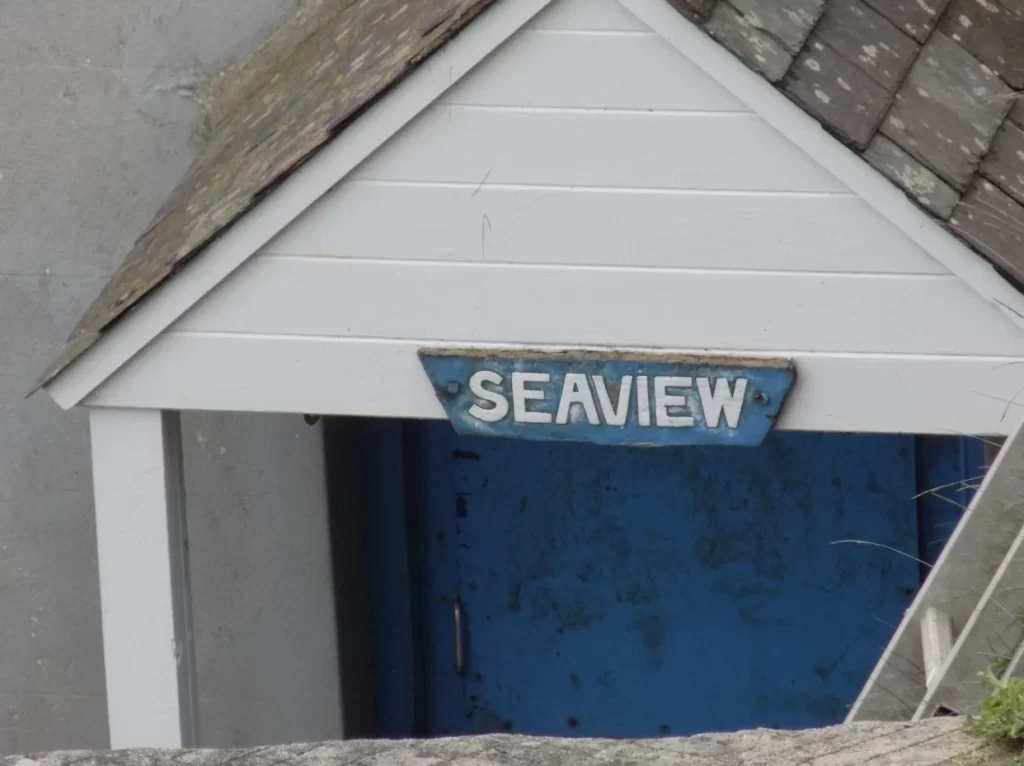

A common theme you will notice with my blog posts is that I have a keen interest in the history. It is all well and good to view a place in that moment and then write about it but importantly for me, it is about seeing that place in the context of what caused it to be that way. Before I continue on with our little adventure, I will give you an account of the history of the Hallsands village.
Hallsands is a very quaint village with a rich human history. It also has some very interesting moments that make it all the more unique. It served as a fishing village that was officially founded in 1784 when the first property title deeds were registered with the land registry. Built on a rock ledge the fisherman chose the unusual location of Hallsands to set up for even more unusual reasons.
By 1784 there were measures in place to prevent piracy and smuggling, this meant that fisherman were free to take up areas of the coastline without fear of pirates. It seems a bizarre notion in modern Britain, but piracy was a huge blight on the fisherman’s livelihood and choosing a safe location to reside was paramount. Being on a rocky outcrop also enabled the fisherman easy access to the sea, the village was also secluded and a long way from civilisation enabling people to live without the burdens associated with larger British fishing villages and towns.
The beach below was long and flat which meant that fishing boats could be stored easily and because the community was small, fishing was lucrative in the area compared to other fishing locations that were overfished.
Devon was notoriously bad for road conditions (and still is) which made transport to Hallsands precarious. It was incredibly rare for any wheeled carts to make it to the village so the fisherman relied on the traditional packhorse to make their way to the market in the nearby fishing town of Dartmouth. The journey would have taken a long time and although the fish were caught fresh and transported immediately, by the time they reached the fishmongers at Dartmouth they would often be a little more spoilt than closely connected fishing locations.
Smuggling in Hallsands
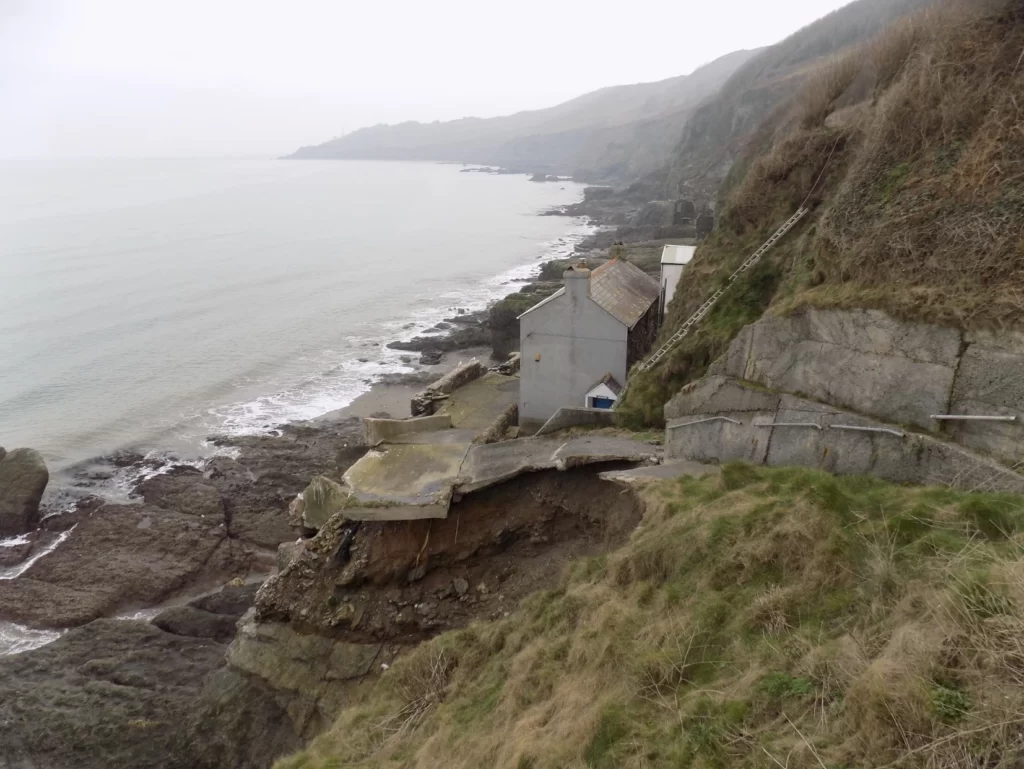

As infrastructure increased in Devon, road access became a little better and the village soon flourished as a small but abundant fishing community. For 50 years of so the community was lively and prosperous. It also became a haven for smugglers who would use Hallsands to smuggle goods without fear of being caught due to its secluded location. Smuggling was very popular because ordinarily goods would be taxed heavily, smugglers were providing luxury goods without the tax tariff meaning everyday folk could enjoy some of the finer things in life.
Hallsands was one of the very few places in Devon where villagers could own their own homes due to the reasonable economy and low property prices. Most villagers by the mid-nineteenth century owned their own homes.
A culmination of things resulted in the smuggling operations of Hallsands declining. The coast guard actively targeted smugglers and it wasn’t long before Hallsands was on their radar, they planted people into the community and then dismantled the smuggling operation from the inside. This proved an effective tactic rather than to try and target individual shipments, the coast guard was successful in identifying smugglers and prosecuting them.
Alongside the smuggling crackdown, Hallsands began to face other problems that posed a major threat to their way of life and existence.
Hallsands Under Fire
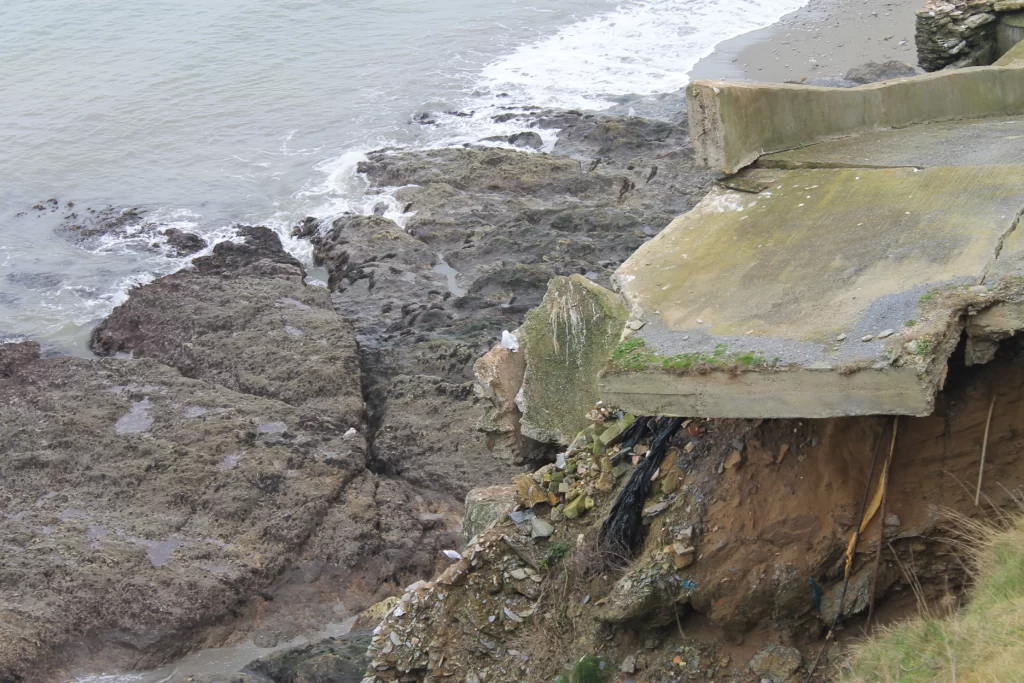

As early as 1897 the village started to encounter problems that would have devastating effects on the population over the next twenty years. In 1897 the shingle barriers were partially removed and not filled in by the villagers to protect the coastline. They appealed to the local authority for help to replace the shingle alters as there were now holes in the defences, unfortunately this plea for help seemed to go unanswered and in June of that year an enquiry was held to assess the problems the Hallsands villagers were facing.
Because of the gaps in the shingle protection fisherman were angry that their pots were being damaged and as a result of the enquiry a goodwill measure was taken with the local authority paying the community a sum of money per male citizen in the village as a means to replace damaged fishing equipment. The conclusion of the enquiry was resounding that although there were holes in the shingle alter, these would soon be filled naturally by long shore drift of new sand.
The Hallsands residents accepted this conclusion and the money and tried to continue village life despite the ongoing issues. This issue was made far worse when in 1894 the Royal Navy (with plans to extend Devenport Dockyard) removed a huge quantity of shingle from the coastline around Hallsands. This action was taken without a consultation occurring and villagers were left completely in the dark.
By 1902, dredging of the shingle had begun to take a heavy toll on the village and residents realised that this massive dredging operation was threatening their quiet and peaceful existence. They took action by removing the dredger mark buoys and pulling them to shore to prevent further dredging. Unbeknownst to them it was too little too late and although the licence to dredge was revoked a few days later, almost 650,000 tonnes of shingle had been removed over the last five years.
Catastrophe Imminent
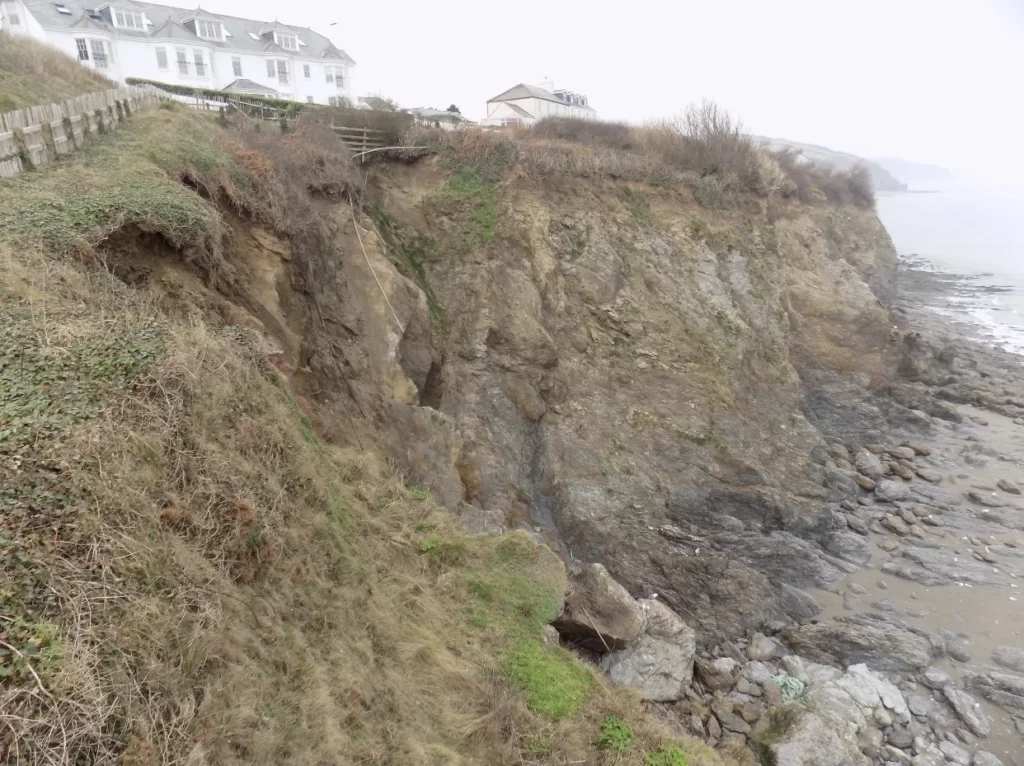

Dredging had dropped the shoreline by a staggering six feet, leaving the rock top village exposed to the waves and tide. In 1903 the villagers with the help of Richard Hansford, who acted on their behalf for free, petitioned the local authority with evidence that the enquiry findings of sediment replacement were false and that with the subsequent dredging the village was under immediate threat.
In 1903 a paltry offer of £1000 is offered to the villagers for damage to property, loss of fishing equipment and to build a sea wall. This amount was vastly under the value of the true cost and the majority of villager’s declined the offer, seeking a more robust settlement offer.
Hallsands is Lost to the Sea
By late 1903, the effects of the dredging and shingle removal began to show drastically. The London Inn, a major village building was the first to suffer extensive damage when its kitchen, beer cellar and a bedroom simply collapse where the cliff had eroded away beneath them. In 1904, the local authority tried again to offer punitive compensation at £1750. Although this was still vastly under the value of the actual damage caused, villagers were more receptive to this as it became apparent that time was running out.
They countered with an offer to accept £3000 with further funds being raised by a local newspaper and compensation from the board of trade. By late 1904, strong gale force winds had ravaged the remaining village defences, causing further damage to the village protective wall and other properties. The money the villagers had been compensated with was used to rebuild the wall as well as repair properties.
Alarmingly, no action had been taken to replace the shingle or rebuild the overall village defences which still bore the holes made decades before.
By 1906, four families had lost their homes entirely to the sea and the village population was beginning to reduce. Those four families were re-housed further up the hill in a set of new-built cottages. Twenty-five cottages remain at this time and a total of ninety-three villagers. At this time an effort is made to build sea defences with a focus on preserving the village and its property.
The Fateful Night of 26th January 1917
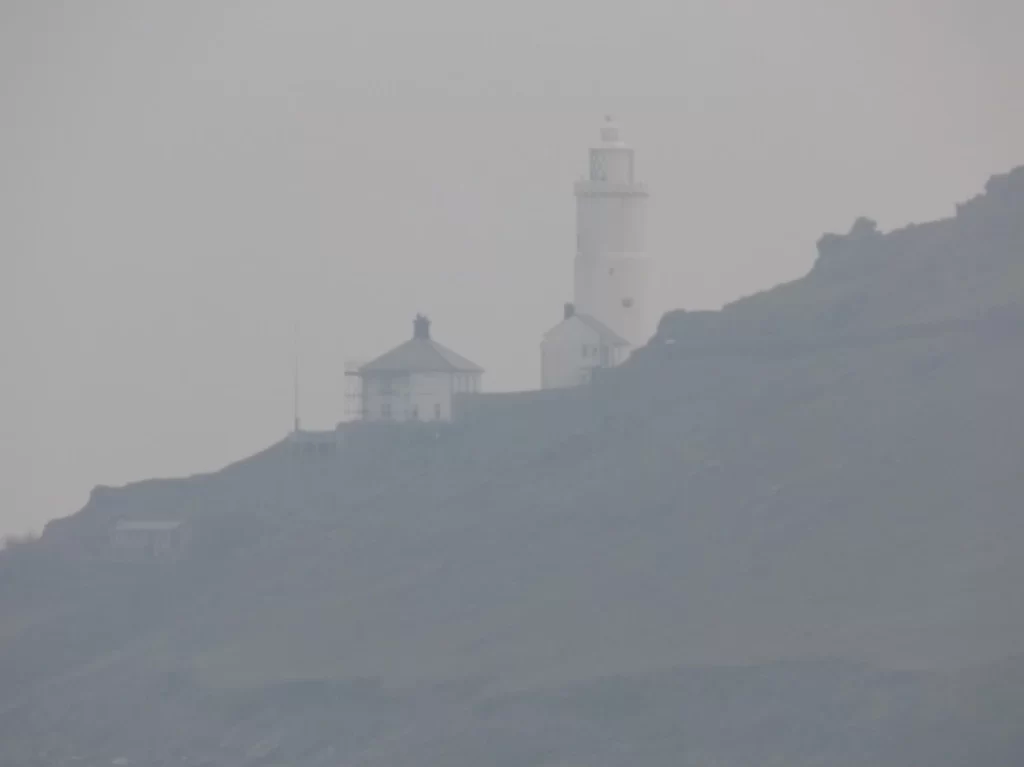

Over ten years passed with the village remaining on high alert but largely protected by their earlier defence measures. That is until 8pm on the 26th of January when spring tides bring a barrage of waves to the village accompanied by a heavy coastal storm. The tidal forces overwhelm the sea defences and are so high that they crash over the village at roof height, decimating the village. The waves rain down from above causing many of the properties to be majorly damaged, with four being completely decimated.
Fortunately, and by sheer luck, all inhabitants manage to make it out of their houses and seek refuge away from the village and further up the hill.
By the morning of January 27th, the village lies in ruins. Those properties that had managed to withstand being swept away were obliterated. On the 28th, a further storm ravaged Hallsands and in its wake leaves an uninhabitable wasteland with little to salvage. In two nights, two centuries of history, memories, births, marriages, deaths, happy family moments, success, prosperity and community spirit had been completely removed from existence. Save for a few sorry ruins.
The Kingsbridge Gazette’s headline reads;
“The beach went to Devonport and the cottages went to the sea.”
The Aftermath
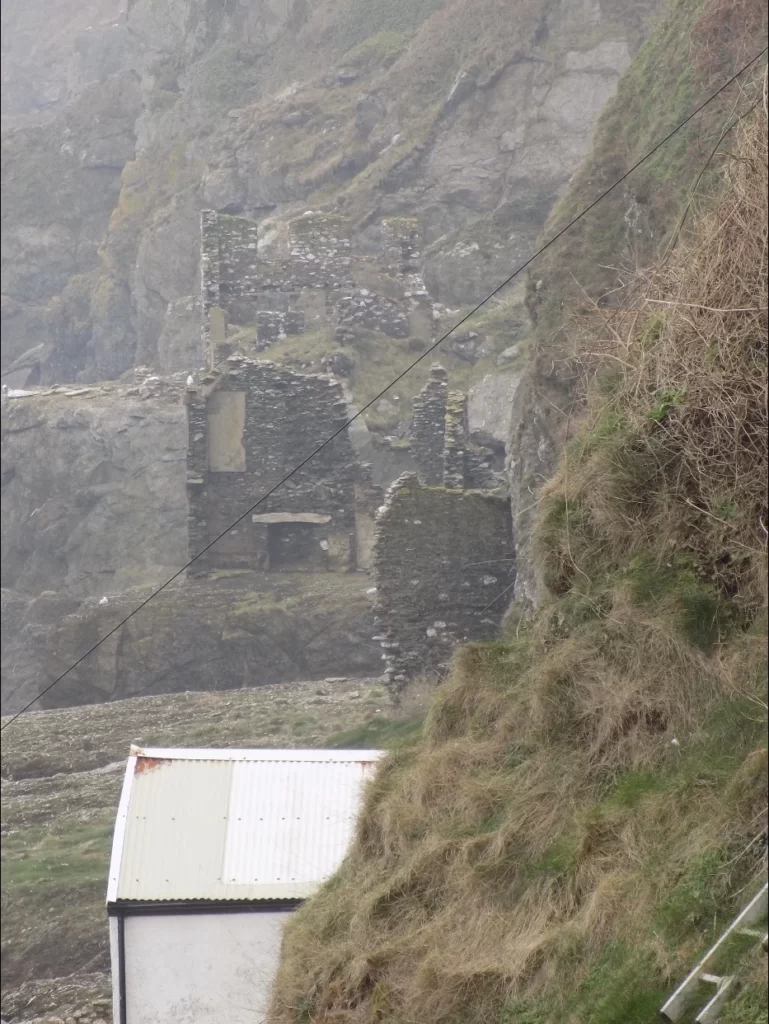

I would love to write a happy ending, tell you about how the villagers were fully compensated and relocated to lovely inland cottages where they lived out the rest of their lives happily, putting the events of Hallsands behind them.
I can’t write that ending. In the aftermath of the storm and with Britain at war, the villagers were left to fend for themselves. Many sheltered in nearby barns that farmers kindly allowed them to stay in until they got back on their feet. Hallsands was a vibrant and successful fishing community on the fringes of the Devonshire coastline. Life long fisherman are ill equipped to deal with job skills outside of fishing and many of the families were left in abject poverty, destitute with no way of making ends meet.
Some respite was offered by the Fisheries Committee who managed to rebuild ten houses in what is now known as North Hallsands. Six houses were built independently. That meant that only sixteen of the thirty-seven houses were replaced. Little is known about the surviving inhabitants of Hallsands, instead the plaque that adorns the viewing platform drifts off vaguely in much the same way the village drifted into the sea.
The End of Our First Adventure
We trudged back up the steep hill, all of us a little quiet and subdued. Hallsands is a silent place, even the waves below seemed dull against the atmosphere of the viewing point. I got the sense that the villagers might have escaped with their lives, but they died that night with the village.
By the top of the hill we are met by the new build complex and everything seemed right with the world again. We put Hallsands in our rear-view mirror for a straight blast up the M5. The sun is shining, the windows are open and our mood is good. We had an amazing day out after all, and we won’t forget Hallsands, even if the rest of the world has.
